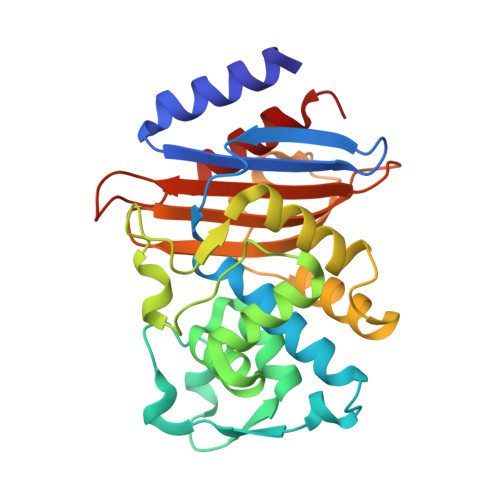Structural insight into potent broad-spectrum inhibition with reversible recyclization mechanism: avibactam in complex with CTX-M-15 and Pseudomonas aeruginosa AmpC beta-lactamases
Lahiri, S.D., Mangani, S., Durand-Reville, T., Benvenuti, M., De Luca, F., Sanyal, G., Docquier, J.D.(2013) Antimicrob Agents Chemother 57: 2496-2505
- PubMed: 23439634
- DOI: https://doi.org/10.1128/AAC.02247-12
- Primary Citation of Related Structures:
4GZB, 4HBT, 4HBU, 4HEF - PubMed Abstract:
Although β-lactams have been the most effective class of antibacterial agents used in clinical practice for the past half century, their effectiveness on Gram-negative bacteria has been eroded due to the emergence and spread of β-lactamase enzymes that are not affected by currently marketed β-lactam/β-lactamase inhibitor combinations. Avibactam is a novel, covalent, non-β-lactam β-lactamase inhibitor presently in clinical development in combination with either ceftaroline or ceftazidime. In vitro studies show that avibactam may restore the broad-spectrum activity of cephalosporins against class A, class C, and some class D β-lactamases. Here we describe the structures of two clinically important β-lactamase enzymes bound to avibactam, the class A CTX-M-15 extended-spectrum β-lactamase and the class C Pseudomonas aeruginosa AmpC β-lactamase, which together provide insight into the binding modes for the respective enzyme classes. The structures reveal similar binding modes in both enzymes and thus provide a rationale for the broad-spectrum inhibitory activity of avibactam. Identification of the key residues surrounding the binding pocket allows for a better understanding of the potency of this scaffold. Finally, avibactam has recently been shown to be a reversible inhibitor, and the structures provide insights into the mechanism of avibactam recyclization. Analysis of the ultra-high-resolution CTX-M-15 structure suggests how the deacylation mechanism favors recyclization over hydrolysis.
- Infection Biosciences, AstraZeneca R&D Boston, Waltham, Massachusetts, USA.
Organizational Affiliation:



















